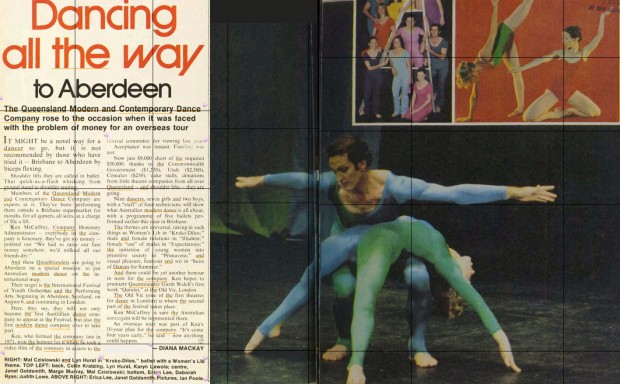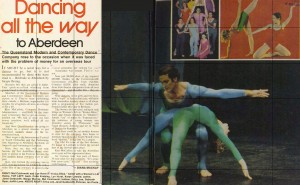So I’ve finally got around to doing a blog. But what to blog about for the first time? One of my projects? That seems a bit naïf and self-focused for my first post at the least.
So I thought I’d blog about something that existed before my time, and that I believe was an important part of the history of dance in Brisbane and Queensland. I believe that it is important to sometimes look back and learn a little from the past.
The Queensland Modern and Contemporary Dance Company that existed in Brisbane from 1971 until approximately 1980. About two years ago, I decided to start casually researching the company in my spare time. Given such limited spare time, it has been a bit of a stop/start project, but worthwhile nonetheless. There is still much to learn, but I thought I’d share some of my findings.
As an artist I believe it is important to know about work created before your time (especially in your home town) – not just so you don’t look like an idiot when you name a new work “Three Women”(as made in the past), to identity any lineage (in the form of ideas, movement, motivation) passed down, as well as to have an understanding about where your own work sits in context.
Unfortunately there is little documented about the Queensland Modern and Contemporary Dance Company. If you ask any tertiary dance student in Brisbane, (if they have listened in dance history 101), they would be able to recount the history of the Queensland Ballet, Dance North and Expressions. But not the Queensland Modern and Contemporary Dance Company. Sadly, most know nothing of it. But that’s a fair call. Try googling it. Nothing right!
In a similar way to how it frustrates me that we’ve lost so many old buildings in Brisbane, it also frustrates me that there’s limited research/ information documented about this company. This has led me to want to know more about its work; it’s members, and their experiences.
For me, what makes the company particularly interesting is the cultural and political landscape in which the company existed. A particularly conservative time in Queensland, I wondered how the company’s works were received by audiences, and I was particularly interest to know how they were supported financially.
One thing I was able to find was an article in Woman’s Day. Yes, that’s right, Woman’s Day! And with a double page spread on a contemporary dance company!
I found this documentary:
http://www.abc.net.au/4corners/stories/2011/08/08/3288475.htm
At 26:45 minutes into the story, the report speaks of Utah’s philanthropic endeavors, and says that: “Utah financed grants totaling 1.5 million that year” and that they “Financed grants totaling $50,000 Grant to the Australia Opera Company to which the Utah mining company itself added another $200, 000″. Furthermore, in the ABC Four Corners documentary, Queensland Premier, Sir Joh Bjelke-Petersen faces pointed questions from reporter Paul Lyneham about his ownership of coal shares. Lyneham also provokes a fierce response from the mining company, Utah Development Corporation, by questioning its relationship with the Queensland government.
This article from 1976 (attached) features a photo of the Queensland Modern and Contemporary Dance Company and mentions that their support through the Utah mining company’s Utah Foundation set up in 1975 – just like in the documentary!
(from http://trove.nla.gov.au/ndp/del/article/55477253)
The connection between the ABC Four Corners story and the article (below) not only gives insight into how the company was funded, but to the political landscape of the time.
Seeing a contemporary dance story in Woman’s Day (probably between recipe pages for chicken Kiev, and adverts for sun tanning oils) I quickly realised this ‘story’ was clearly also an advertisement for Utah – in their ‘feel good” advertising propaganda attempts (mentioned earlier in the Four Corners program).
Finally in context to current dance in Queensland, as I’ve started to track down members and research the company (slowly), I have learned that the company had an excellent reputation for making innovative dance work. I have learned that had some very high profile guest choreographers make work on the company. It seemed there was a different resident choreographer per year.
Graeme Watson was the company choreographer in 1974. When I asked him about how the work of the company was received given conservative Brisbane in 1974 (think even pre punk times), I was surprised to learn that it was in fact very well received; because audiences were hungry to see dance, partially because they had little to compare it to, but mostly because the company was making some really great edgy work on par with other leading dance companies.
It’s quite shameful that I expected to hear otherwise. But I have to admit, that for as long as I can remember, Queensland has had a bit of a hard time proving itself on par with dance in other states. Yes, maybe there was some average dance work made in the 80′s and 90′s. But I don’t think this is the case anymore and in fact that the likes of Expressions Dance Co and Dance North are being so well received and making such successful work. It frustrates me that it is still such a battle for Queensland dance makers in many ways.
I can confidently say that Qld Modern & Contemporary Dance Company was a leader of dance in Brisbane and Queensland in the 1970′s, making innovative work with a strong audience base that toured internationally and regionally. What I have discovered so far about the Queensland Modern and Contemporary Dance Company has been very affirming – Learning that Queensland dance had very solid and reputable history and that Queensland was in fact a leader of innovative dance in previous years.

